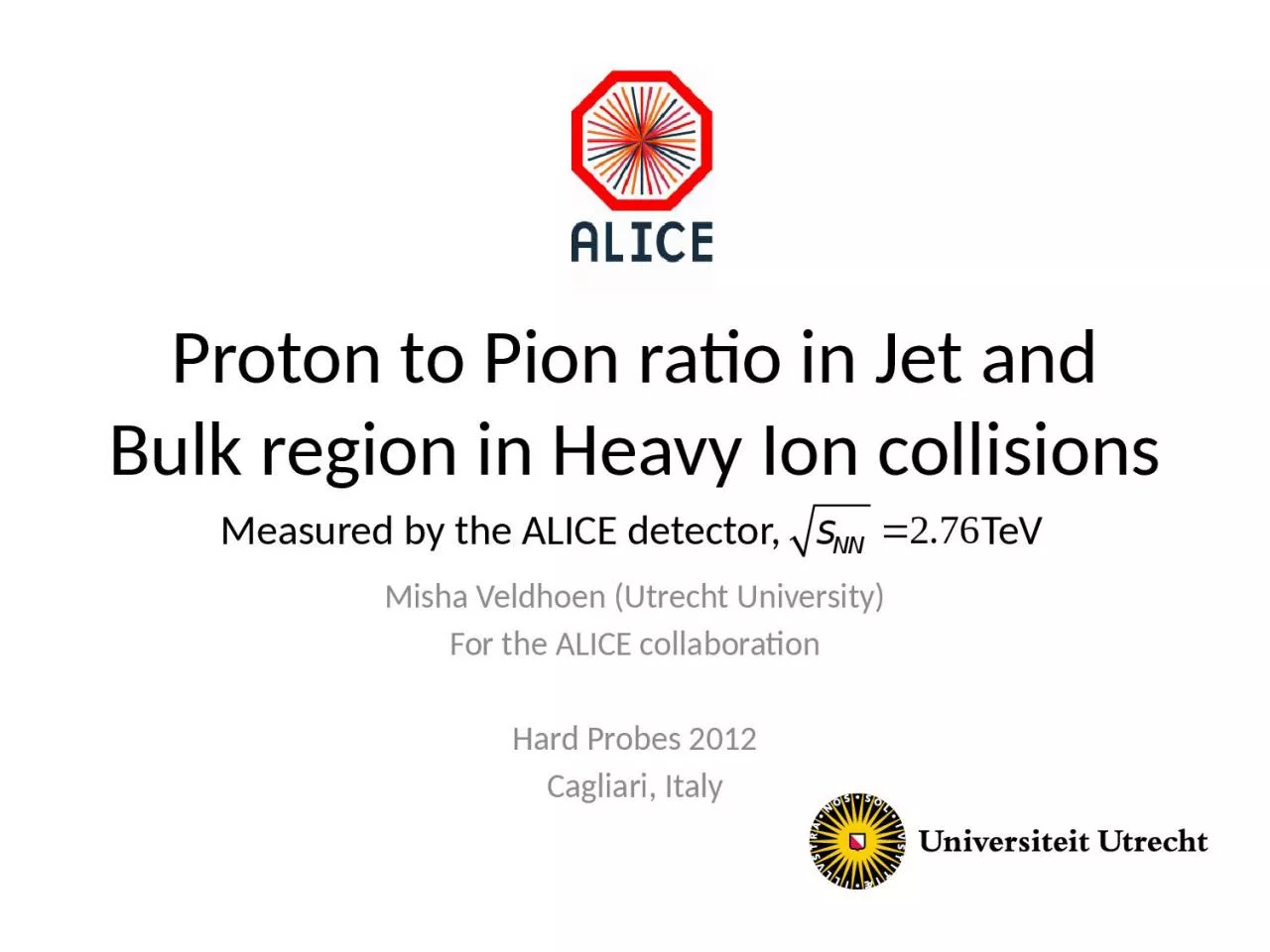

Misha Veldhoen Utrecht University For the ALICE collaboration Hard Probes 2012 Cagliari Italy Measured by the ALICE detector TeV Hadronization at high and low ID: 1046391
Download Presentation The PPT/PDF document "Proton to Pion ratio in Jet and Bulk reg..." is the property of its rightful owner. Permission is granted to download and print the materials on this web site for personal, non-commercial use only, and to display it on your personal computer provided you do not modify the materials and that you retain all copyright notices contained in the materials. By downloading content from our website, you accept the terms of this agreement.
1. Proton to Pion ratio in Jet and Bulk region in Heavy Ion collisionsMisha Veldhoen (Utrecht University)For the ALICE collaborationHard Probes 2012Cagliari, ItalyMeasured by the ALICE detector, TeV
2. Hadronization at high and low pT1In A–A collisions, for pT < 6 GeV/c, a significantly enhanced Baryon to Meson ratio is observed.In p—p collisions the dominant particle production mechanism is fragmentation.
3. Reproducing the Baryon EnhancementOne possible hadronization mechanism at pT < 6 GeV is coalescence/recombination. 2Recombination and HydroHydrodynamicsHot matter BaryonpT = 3pT,parton MesonpT = 2pT,partonHydrodynamic models reproduce the charged particle spectra and ratiosfor pT < 2 GeV/c.Thermal RecombinationarXiv:1202.3233arXiv:1202.3233
4. Hadronization in JetsWhat about hadronization in Jets? Several predictions have been made.3Shower-Thermal Recombination,(enhanced B/M should beobserved in Jets) [Hwa, Yang]Medium effects, MLLA+LPHDformalism [Sapeta, Wiedemann]also predicts enhanced B/M ratio in Jets.We will present a measurement of the p/π ratio in the Jet peak and Bulk region of a di-hadron correlation.Baryon pT=3pT,partonMesonpT=2pT,partonHard partonHot matterarXiv:0707.3494K±/π±p(p)/π±-RatiopT (GeV/c)
5. Di-Hadron Correlations1.4M central (0-10%) Pb—Pb.Associated particles: 1.5 < pT < 4.5 GeV/c,Trigger particles: 5.0 < pT < 10.0 GeV/c.|η| < 0.8.PID using TOF and TPC.CorrectionsMixed event correction (pair acceptance).Efficiency (tracking and PID) as function of pT and particle species.No feed-down correction, Λ spectrum in jets not known.4
6. Selecting Peak and Bulk RegionsFive-dimensional histogram:Peak- and Bulk regions canbe selected by integratingover Δϕ and Δη.5BulkJet = Peak – BulkΔϕ0πΔϕ (rad)ΔηCount
7. Combined PID: TPC and TOFSpecific energy loss, Time Projection Chamber (TPC)Time Of Flight (TOF) Good separation between pions, kaons and protons at intermediate pT.πππpppKKK6tTOF– <tTOF>π (ps)dE/dx – <dE/dx>π (a.u.)dE/dx – <dE/dx>π (a.u.)dE/dx – <dE/dx>π (a.u.)CountCountCountCount3.0 < pT < 3.5 GeV/c3.5 < pT < 4.0 GeV/c4.0 < pT < 4.5 GeV/cCounttTOF– <tTOF>π (ps)CounttTOF– <tTOF>π (ps)
8. Combined PID: Peak ShapespKπpKπpKπExpected PID signals depend on pT and η Non-Gaussian peak shapes.Generated templates to fit non-Gaussian peaks.7Mass Assumption: PionsMass Assumption: KaonsMass Assumption: ProtonsdE/dx – <dE/dx>p (a.u.)dE/dx – <dE/dx>K (a.u.)dE/dx – <dE/dx>π (a.u.)CounttTOF– <tTOF>π (ps)CountCountCountCounttTOF– <tTOF>K (ps)CounttTOF– <tTOF>p (ps)
9. Combined PID: Fit Example IData, mass assumption: pions.ppKKπππ1.2.3.8Kaon and Proton templates subtracted, remaining peak fitted with a function (Gauss+Tail).Final fit, pions (function), kaons and protons (template)tTOF– <tTOF>π (ps)CountdE/dx – <dE/dx>π (a.u.)dE/dx – <dE/dx>π (a.u.)dE/dx – <dE/dx>π (a.u.)CountCountCountCounttTOF– <tTOF>π (ps)CounttTOF– <tTOF>π (ps)
10. Combined PID: Fit Example II4.5.9Slice through the pion peak (TOF).Slice through the proton peak (TPC).tTOF– <tTOF>π (ps)dE/dx – <dE/dx>π (a.u.)CountCount
11. Proton and Pion Yields in Peak and BulkBulk yieldnormalizedto peak region:-0.52 < Δϕ < 0.52,-0.6 < Δη < 0.6Correlated anduncorrelateduncertaintiesshownseparately.pT,assoc (GeV/c)pT,assoc (GeV/c)101/Ntrig dN/dpT,assoc (GeV/c)-11/Ntrig dN/dpT,assoc (GeV/c)-1pT,assoc (GeV/c)ππppCount1/Ntrig dN/dpT,assoc (GeV/c)-1pT,assoc (GeV/c)Count1/Ntrig dN/dpT,assoc (GeV/c)-1
12. p/π Ratiop/π Ratio in Bulk region (-0.52 < Δφ < 0.52 rad, ±0.60 < Δη < ± 1.50)Results not feed-down corrected.11
13. p/π RatioComparison with feed-down corrected p/π ratio, from inclusive spectra (0-5%), (QM2010 prel.)Inclusive spectra used |y| < 0.5 instead of |η| < 0.8.12
14. p/π RatioComparison with the p/π Ratio in the Jet (Peak – Bulk) (-0.52 < Δφ < 0.52 rad, -0.40 < Δη < 0.40)Jet ratio not feed-down corrected.Significant difference between Bulk and Jet ratio. 13
15. p/π RatioComparison with Pythia p/π ratio in Jet. (Pythia v6.4.21, default tune)Pythia p/π ratio agrees with measured Pb–Pb p/π ratio in Jet.Particle production in Jet dominated by fragmentation.No evidence for medium modification.14
16. Summary and Conclusionsp/π Ratios in the Jet and Bulk of a di-hadron correlation were presented.Particles identified using both TPC and TOF.The p/π ratio in Bulk is compatible with the p/π ratio from feed down corrected inclusive spectra in the range 1.5 < pT < 3.0 GeV/c.The p/π ratio in the Jet is compatible with a Pythia curve in the range 2.0 < pT < 4.0 GeV/c. (Pythia v6.4.21, default tune)Our measurement suggests that particle production mechanism in jets is dominated by fragmentation. No evidence for medium modification.15
17. BACKUP16
18. Fit Quality17(Data-Fit)/Data (Data-Fit)/σstat